Related Content
Content
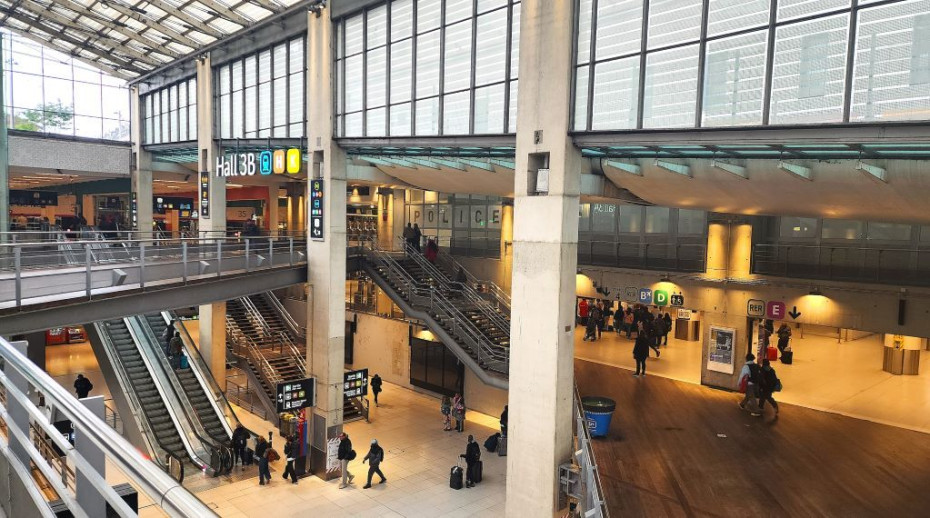
Share
If you want to opt to make the transfer between the Gare Du Nord and the Gare De Lyon by public transport, taking the RER train is the best option.
The four positives are:
(1) It’s comparatively fast - it’s a two station hop on Ligne D (Sud) - the green line, so you can be the concourse at Gare De Lyon, within 25 mins of entering the RER station at the Gare Du Nord.
(2)The line D platforms at the Gare Du Nord and Gare De Lyon stations have both been brightened up; and numerous staff can usually be found on the platforms at Gare Du Nord, so the station has lost much of what had been a somewhat intimidating atmosphere.
(3) It's cheap, a single central zone metro ticket can also be used on the RER.
(4) It's generally reliable, you won’t have to wait more than 12 minutes for a train and delays are very rare.
Not so great:
- The air-conditioning on the RER trains can be temperamental, so on a hot day, particularly if you are managing heavy luggage, it can be a tad uncomfortable
- Also the end-to-end the journey can be more confusing than you might imagine, hence the info below.
Step by Step:
The RER Line D (Sud), which is the green line, provides the direct public transport link across central Paris between the Gare Du Nord and the Gare De Lyon - on this line the RER trains are double-decked local trains.
The transfer from being on the Hall 1 concourse at the Gare Du Nord, having arrived by Eurostar or InOui trains, to being on the concourse awaiting departure at the Gare De Lyon, will take a minimum of 20 mins.
However, these factors can increase that time to a more typical 35 to 45mins:
- If your seats are towards the rear of a train on arrival at the Gare Du Nord, it can take 5 mins to be on the concourse and heading for the RER trains - which are on the opposite side of the station from Eurostar arrivals.
- The need to buy a ticket for the RER transfer, as it won't be included in the ticket which covers the trains to and from Paris - See below on how to avoid being in a long line for a ticket machine.
- There can be gaps of up to 12 mins between the departures of the line D trains
So if you're against the clock and the next line D (Sud) train won't be due for more than 5 mins , check to see if a line B Sud train is about to depart from the opposite platform
If is you can board it for a one station hop to Chatelet Les Halles, because at that station a simple cross-platform transfer will be available to Line A trains on to the Gare De Lyon.
Though when you're at the Gare Du Nord, you won't know when the next Line A train will be leaving from Chatelet Les Halles, but if you find yourself in a nothing to lose situation, it can be worth taking a chance.
1. Accessing the RER station:
The access from the Eurostar arrivals to the main concourse at Gare Du Nord is all on one level; the exits from the voies (platforms/tracks) will be steps away from the front of the trains.
When you reach the concourse turn to the left.
Though what you won’t see anywhere at the Gare Du Nord are ‘this way to the Gare De Lyon’ signs.
There are multiple access points to the RER trains across the back of the concourse at the Gare Du Nord.
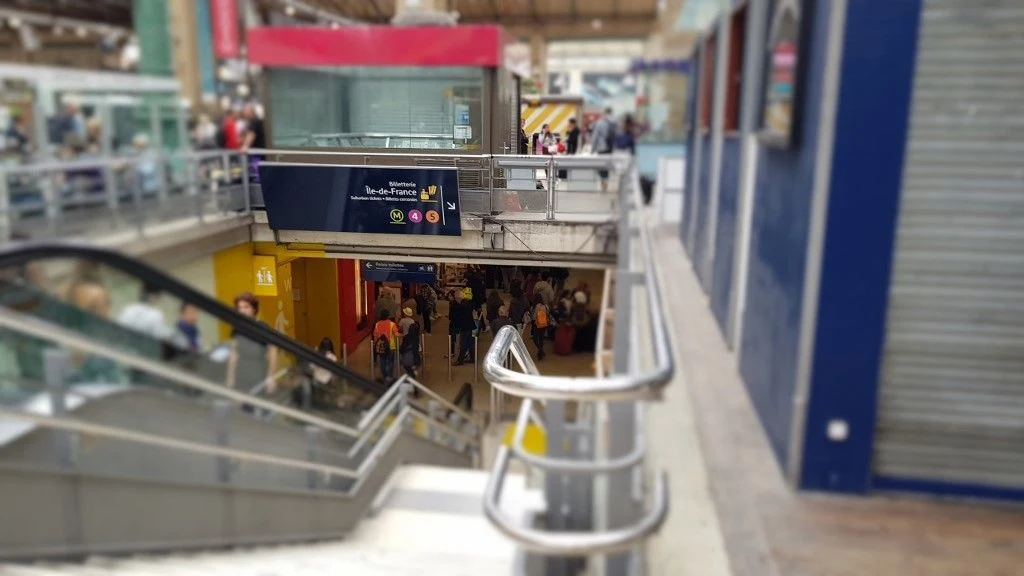
However, the main entrance to the RER station is towards the far left of the concourse (pictured below)
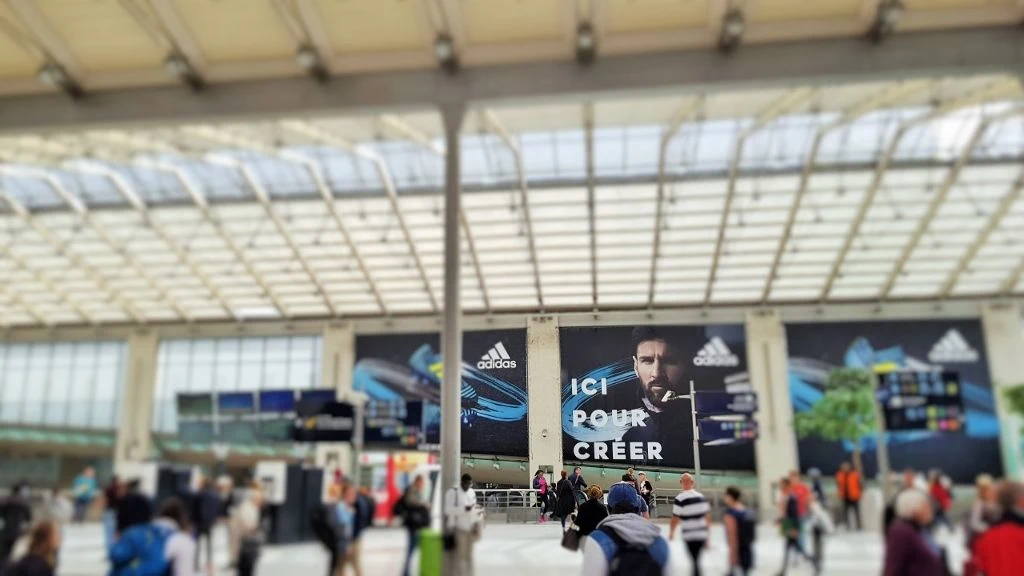
The spacious atrium makes the route to take towards the RER trains comparatively obvious - hence it being SMTJ's preferred route to the RER.
You will come to an escalators which leads down into the RER concourse; This image below has been taken from the top of this escalator.
There is a lift /elevator available, but it is further over to the left, by the entrance to the Hall 3 B
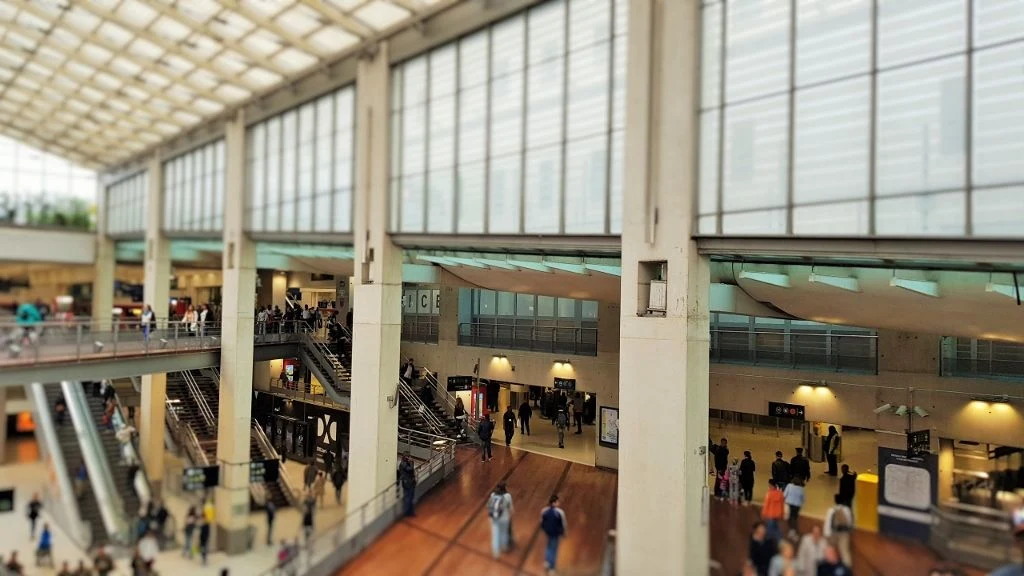
When you reach the foot of the escalator, walk ahead of you into the RER station, the ticket machines and counters for the line D (and B) trains will then be over to the left; the access down to the trains is on the other side of the ticket machines.
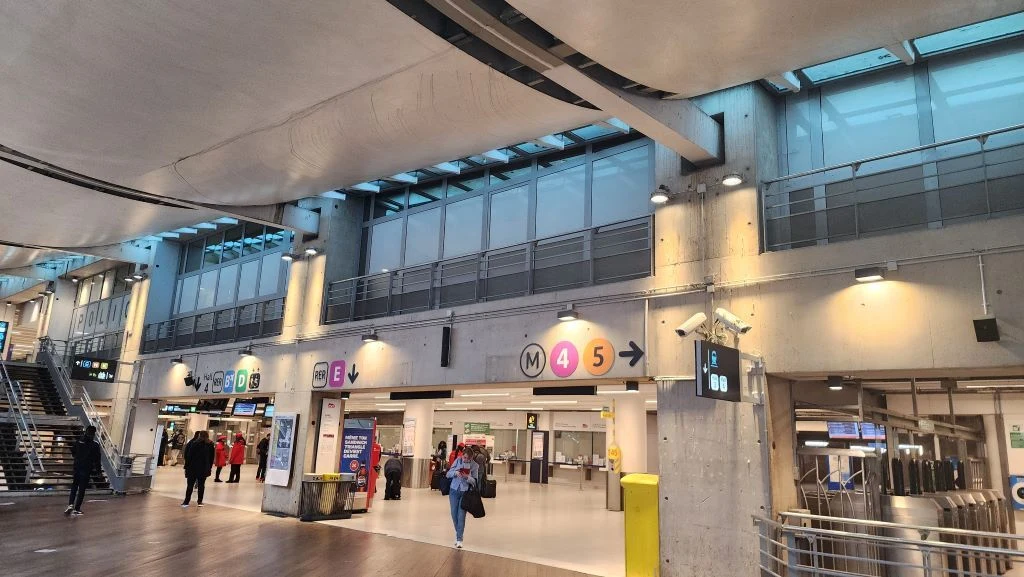
2. Buying a ticket:
Your end-2-end train journey ticket will not include the RER, so you will need to buy a Metro-Train-RER 'ticket' which costs €2.50.
However Paris has pretty much transitioned to a Pay As You Go system named Navigo for its public transport network.
The RER ticket(s) for the journey on to the Gare De Lyon have to be loaded on to a physical / plastic Navigo Card, or purchased on either one of two apps - the Île-de-France Mobilités app, or the Bonjour RATP app.
One card per person, or one app per person.
If you opt to use a card you can tap it on the ticket gates, but if you opt to use an app, you tap the mobile device on which the app is installed, on the ticket gates.
If you don't want to use an app (see below), a Navigo Easy card, which costs €2 is the best option for a journey from the Gare Du Nord to the Gare De Lyon as single journeys can be loaded on to it.
Though if you will be making a return journey which also involves a cross Paris transfer, you can buy two tickets / journeys and load them on to the card.
Some of the ticket machines at the Gare Du Nord will sell the Navigo Easy Cards + the journey(s) in one transaction, you pay and the machine will issue a card with the journey(s) loaded on to it.
Though some machines only allow pre-purchased Navgio Cards to be inserted and loaded.
Of if the staffed ticket counter is open (see below), you can obtain the Navigo Easy cards + the journeys in one transaction at the counter.
Once you have the Navigo Easy card keep it in your card holder and you can then use it when you return to Paris.
At some busy stations you may see staff on the concourse holding mini payment machines, and when you already have the Navigo card, you can approach these staff and add tickets / journeys to the card.
Using the apps
The big plus of the apps is that because you can use mobile banking to pay for transactions the ticket machines and counters at the stations can be avoided.
Post-purchase, you can tap your phone on the card readers on the ticket gates to open them.
Though you need an app / mobile device per person, you cannot purchase tickets / journeys for more than one individual within the app.
However, there are two apps:
1: The Bonjour RATP app keeps things simple and it's the best option if all you'll want to do is purchase the ticket for the RER journey to the Gare De Lyon,
Because the advantage of using it is that you don't have to bother with the Navigo Cards / Passes, as you can buy a ticket(s) online and store them within the app.
Plus it's typically possible to make the purchase(s) in the app before you get to Paris.
2: - Using the Île-de-France Mobilités app - aka the Navigo Pass app
If you have a compatible iPhone or Apple Watch this app is built into the Apple Wallet
You can add it by tapping the Add (+) button in the Wallet app, selecting "Transit Card," and choosing "Navigo".
Though as explained in depth on this excellent guide, downloading the Île-de-France Mobilités app and setting it up for purchase is a multi-step process if you have an Android device - and the phone needs to be NFC compatible.
However, it seems as though you need to be in Paris before you can make any transactions / payments on the app.
So the best methodology seems to be (1) download/ open the app before you set off, then (2) buy the ticket(s) on the app when you get to Paris.
The key difference to the Bonjour Ratp is that you can use an Île-de-France Mobilités app to purchase a range of passes aka 'titles' in addition to the Zone 1-5 tickets.
So it can be particularly worth the bother if you know that you'll be likely to return to Paris for an extended stay.
The excellent parisbytrain website has all the info you will need about metro tickets.
Buying tickets in the station
The staffed ticket counter in the RER station at the Gare Du Nord is only open at certain times of the day, so to mitigate against this, multi-lingual staff can be assigned to ticket machines to ensure the correct ticket is purchased.
However, queues of more than 10 people per ticket machine can be typical!
Also if you have arrived at the Gare Du Nord and don't have a Navigo Card (see above), check that the machine will also issue the Navigo Cards before you join the queue.
The excellent parisbytrain website has all the info you will need about metro tickets.
3. To the RER train:
From the RER concourse follow the signs for ‘Ligne D (Sud)
It’s important to use the ‘Ligne D (Sud)’ ticket gates as there are separate/different ticket barriers for trains heading in the opposite direction (Nord).
If you have luggage, use the lift/elevator on the other side of the ticket gates - it goes directly down to the platforms/tracks.
The RER station at the Gare Du Nord is now housed within a smart mall area - so when you take the initial escalator down, you will find yourself in this mall.
The second set of escalators, which you will see directly ahead of you, typically lead upwards for the benefit of arriving travellers, so you will need to walk around behind them, to the next set of escalators.
They will be be marked RER Line B Sud and RER line D Sud and they will take you down to the train - the train will depart from Voie (platform) 44.
4. On the RER platform / track:
The platform is shared by Line B (Sud) and Line D (Sud) trains, the line B trains use the track towards the wall (voie 42), while the line D trains use the track towards the middle, facing the northbound trains (voie 44).
All Line D trains heading south from the voie 44 will call at the Gare De Lyon which is two station calls from Gare Du Nord, so don't worry about the final destination of the train.
Though you can check the electronic departure screens on the voie/platform to double check that you will be boarding a Line D train; or confirm it with the SNCF staff that are usually on the platform.
5. Boarding the train:
The train will be double deck, but don’t bother with finding a seat, as the travel time is only around 7–8 mins.
It’s easier to wait in the fairly large area just inside by the doors, though allow room for people to alight and board at the intermediate station, Châtelet–Les Halles.
6. Leaving the train at Gare de Lyon:
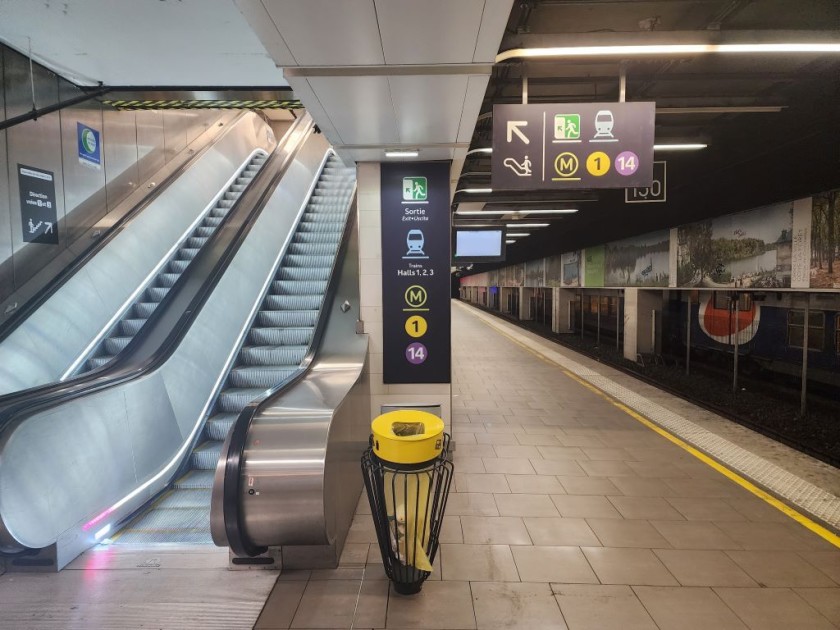
At Gare De Lyon there are escalators and lifts / elevators) up to the level above which houses the exits from the RER.
Though the locations of the lifts / elevators can inevitably be less obvious, so you can use the signs to find them if need be.
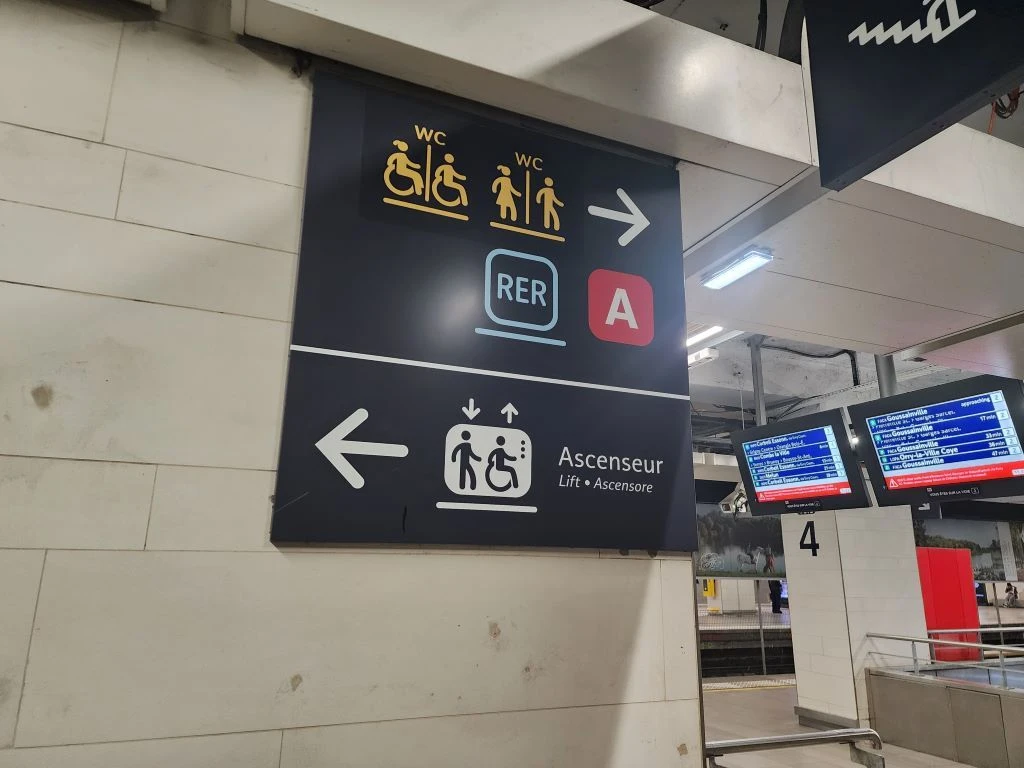
You will ascend up to the RER concourse - note that it's also used by people heading the opposite direction to board an RER train.
It's in effect a large white space, so you need to follow the signs which either point the way to the 'Grande Lignes (mainline trains), or the Halls 1, 2 and 3 -These are the departure halls that the Grande Lignes trains / long-distance trains will be leaving from.
Below is an example of the signage that can be found on this RER concourse.
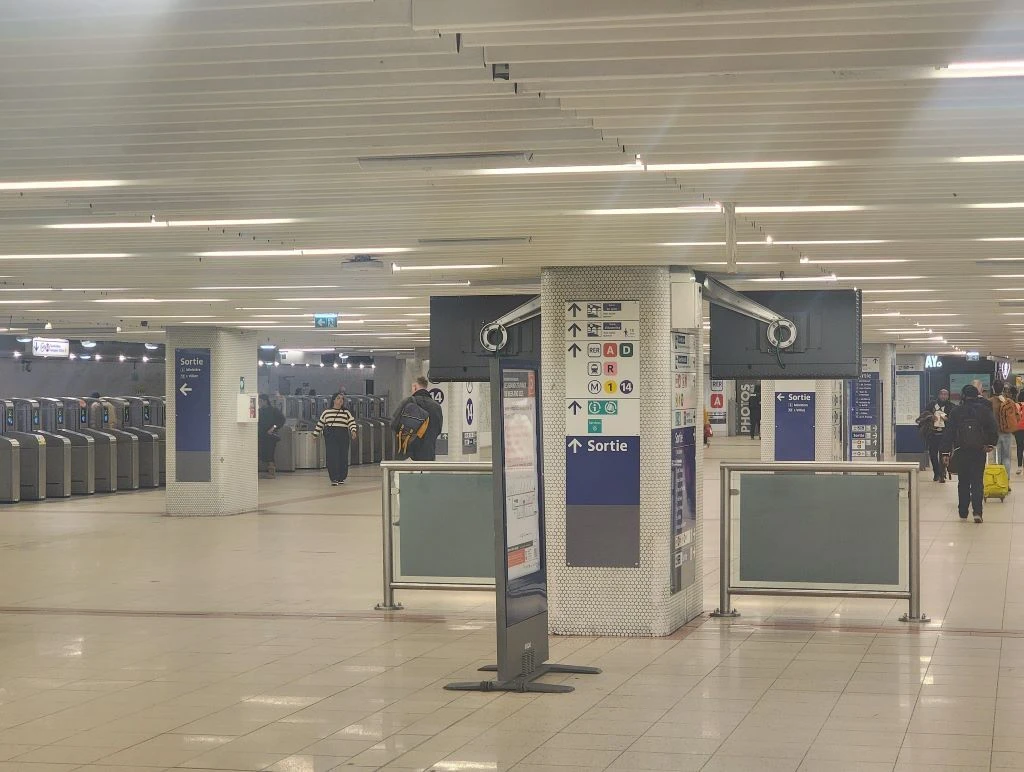
In the middle of the image is a column and on it are multiple direction signs - the one at the top is informing travellers that if you head in this direction, you will be going towards the Grande Lignes trains.
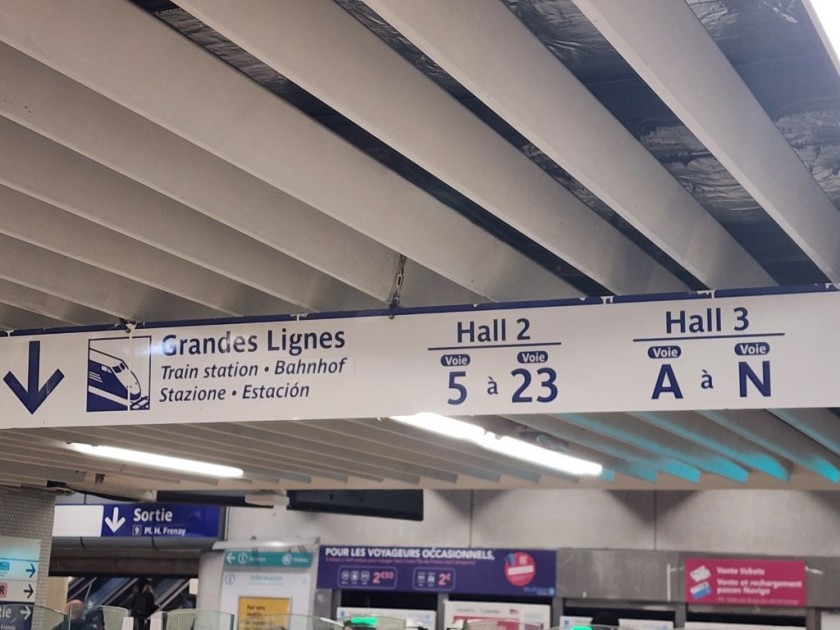
This sign is above the exit gates from the RER station, which lead to the route towards the onward trains.
At this stage there is no need to be aware of which voie (platform / track) or departure hall that your train will be leaving from, the route from here will take you to any onward departure.
7. Heading to your onward train:
When you passed through the gates from the RER station, you will come to the lobby area which leads to the parts of the Gare De Lyon that have the access to the Grande Lignes / mainline trains.
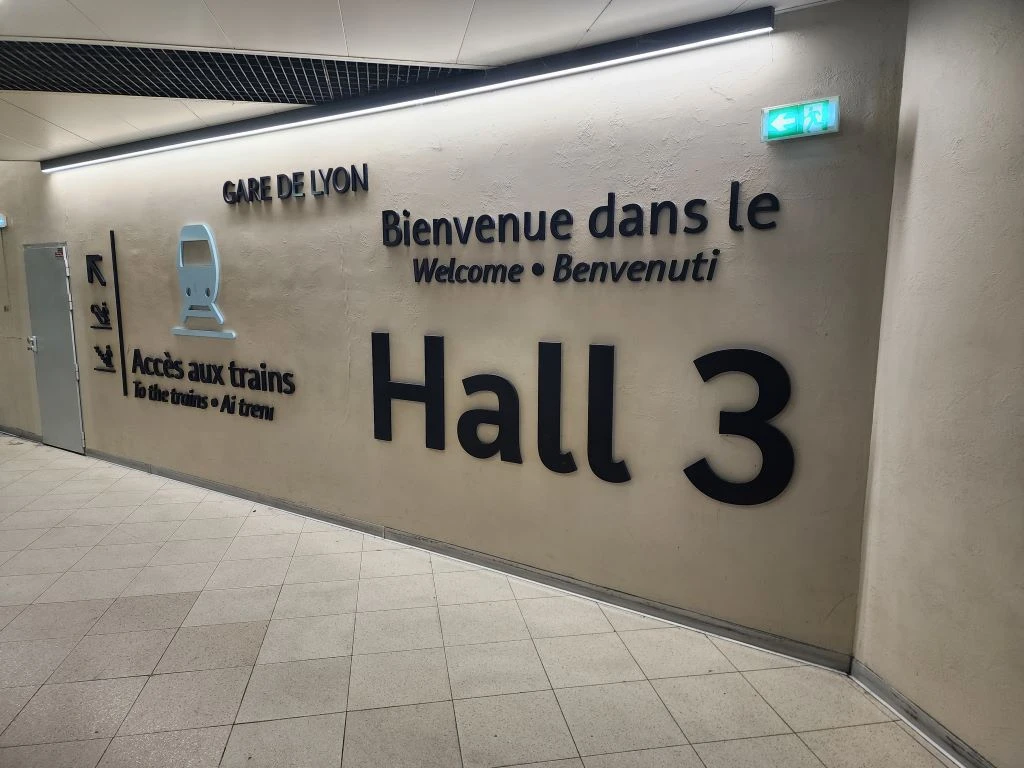
Hall 3 at the Gare De Lyon has a dual function:
- it gives access to onward trains which will be departing from voies (platforms / tracks) E to N.
- it's a passage way which leads to Hall 2, which is where the other onward trains departing from voies (platforms / tracks) 5 - 23
So when you come to the escalators which lead up into Hall 3, you can ascend by them, regardless of which train you will be taking.
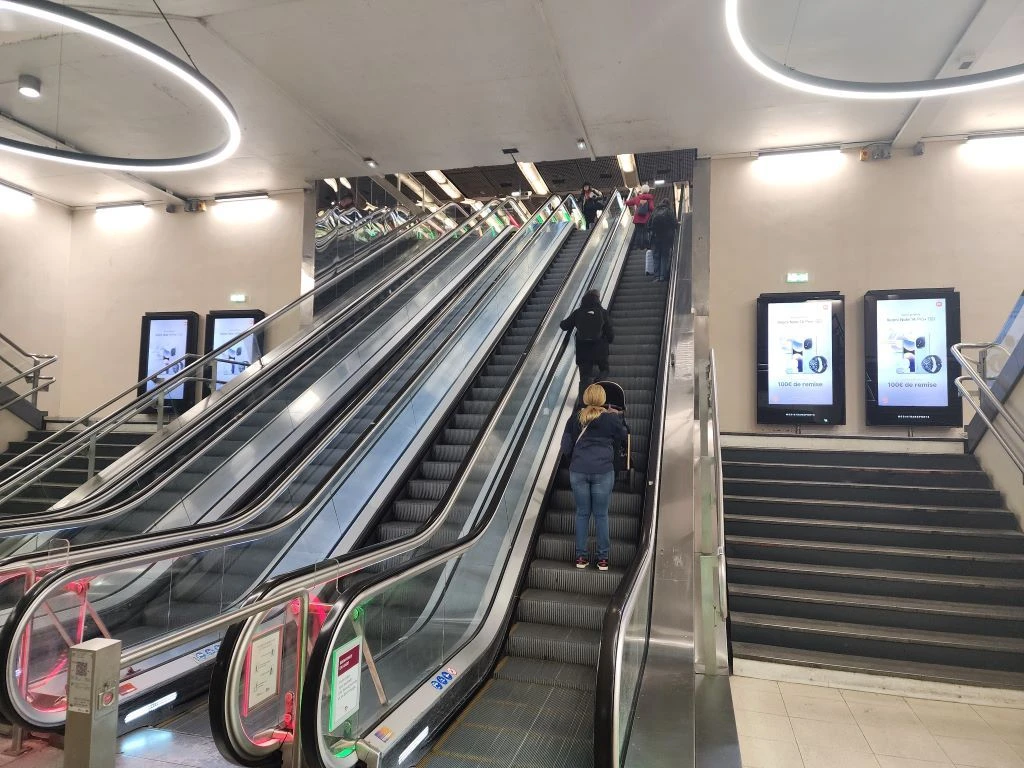
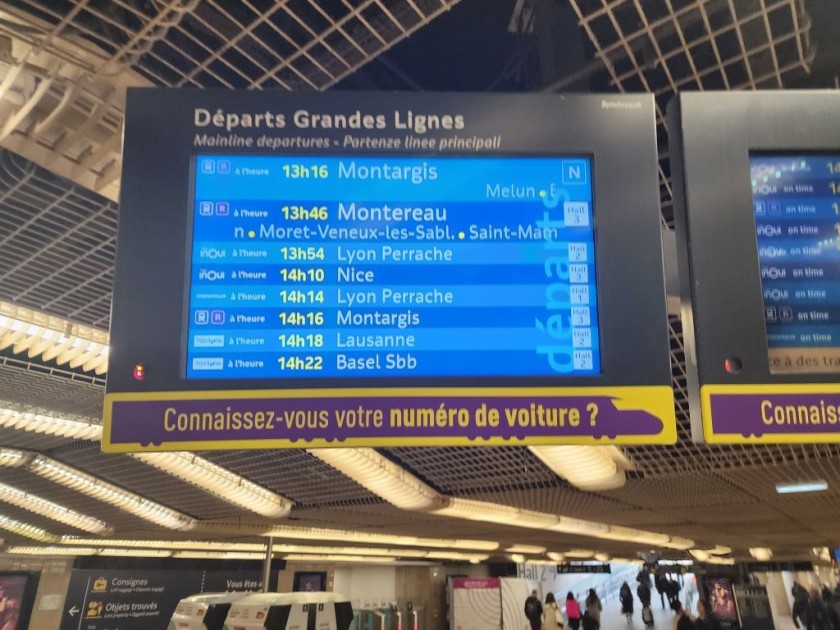
When you have ascended into Hall 3 you can use the blue 'Départs Grande Lignes' screens to check either;
- which voie (platform / track) you need to head to board your onward train - You'll likely see the details of the specific voie (platform / track) if your train will be departing within 15 - 20 minutes, or
- which of the departure halls in which you should wait for the departure details of your train to be confirmed.
Note that for some departures you can remain in Hall 3, there are entrances to each of the voies E to N on the right-hand side.
On the above example, if you happened to be taking:
- the 13:16 train to Montargis - you could proceed directly to voie N
- the 13:46 train to Monteraux - you can wait in Hall 3 for the specific voie that it will be leaving from, to appear on the screen
- the 13:54 train to Lyon Perrache - you should head to Hall 2 to await its departure details, it will be leaving from voies 5 to 23
- the 14:10 train to Nice - you can wait in Hall 3 for the specific voie that it will be leaving from, it will be leaving from voies E to N.
- the 14:14 train to Lyon Perrache - you should head to Hall 1 to await its departure details, the Hall 1 can be accessed from Hall 2
- the 14:18 train to Lausanne and the 14:22 train to Basel - you should head to Hall 2 to await their departure details
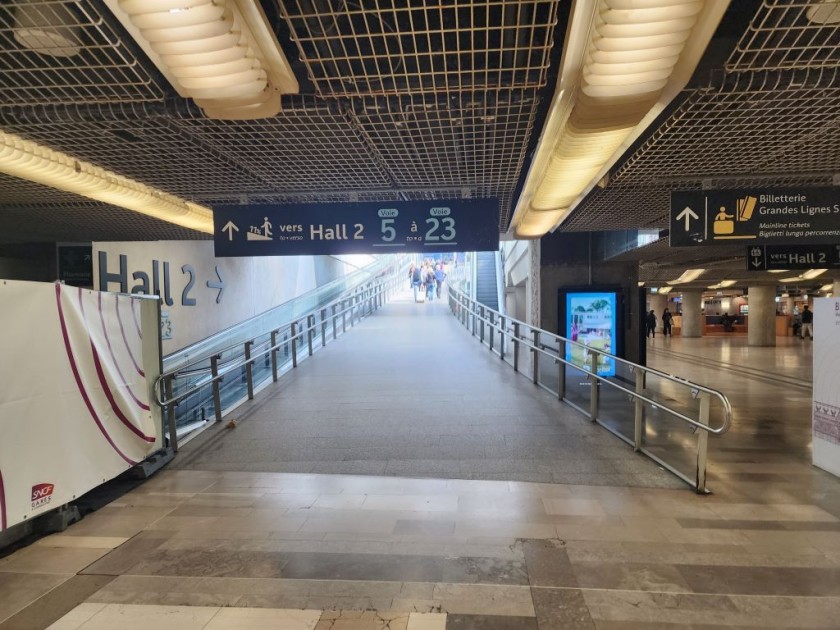
Departing from Hall 2:
Towards the far end of Hall 3 you'll find the access up to Hall 2.
The most obvious route is the sloped pathway beside a moving walkway.
However, if you don't want to drag heavy luggage up the slope and the moving walkway is either unavailable or heading downwards, beyond the slope you'll come to some escalators - at least one of which should be heading upwards.
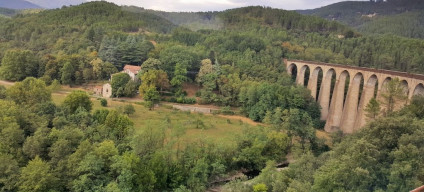
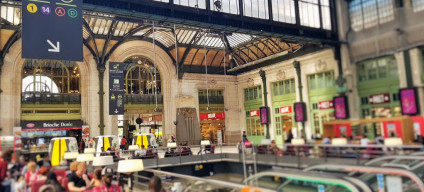

Look for a journey guide
Please support ShowMeTheJourney
This second version of ShowMeTheJourney is exciting and new, so we are genuinely thrilled that you are here and reading this, but we also need your help.
We’re striving not to let anything get in the way of providing the most useful service possible, hence a facility has been set up with DonorBox which can be used to support the running costs and make improvements.
Instead of advertising or paywalls, your financial support will make a positive difference to delivering an enhanced service, as there’s a lot of ideas which we want to make happen.
So if you have found the info provided here to be useful, please go here to say thank you.

Simon Harper
I wanted to share my passion for train travel and explain how anyone can take the fantastic journeys I have taken.

This is one of more than 100 train travel guides available on ShowMeTheJourney, which will make it easier to take the train journeys you want or need to make. As always, all images were captured on trips taken by ShowMeTheJourney.
This second version of ShowMeTheJourney is exciting and new, so we are genuinely thrilled that you are here and reading this, but we also need your help.
We’re striving not to let anything get in the way of providing the most useful service possible, hence a facility has been set up with DonorBox which can be used to support the running costs and make improvements.
Instead of advertising or paywalls, your financial support will make a positive difference to delivering an enhanced service, as there’s a lot of ideas which we want to make happen.
So if you have found the info provided here to be useful, please consider saying thank you.




